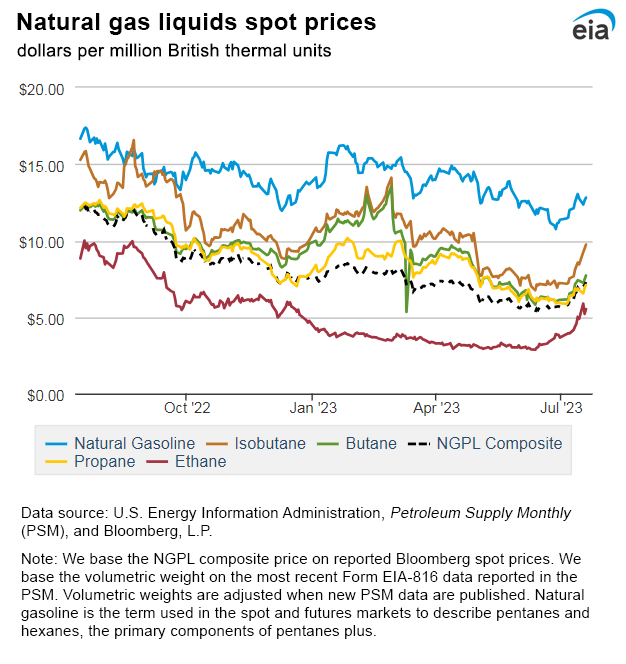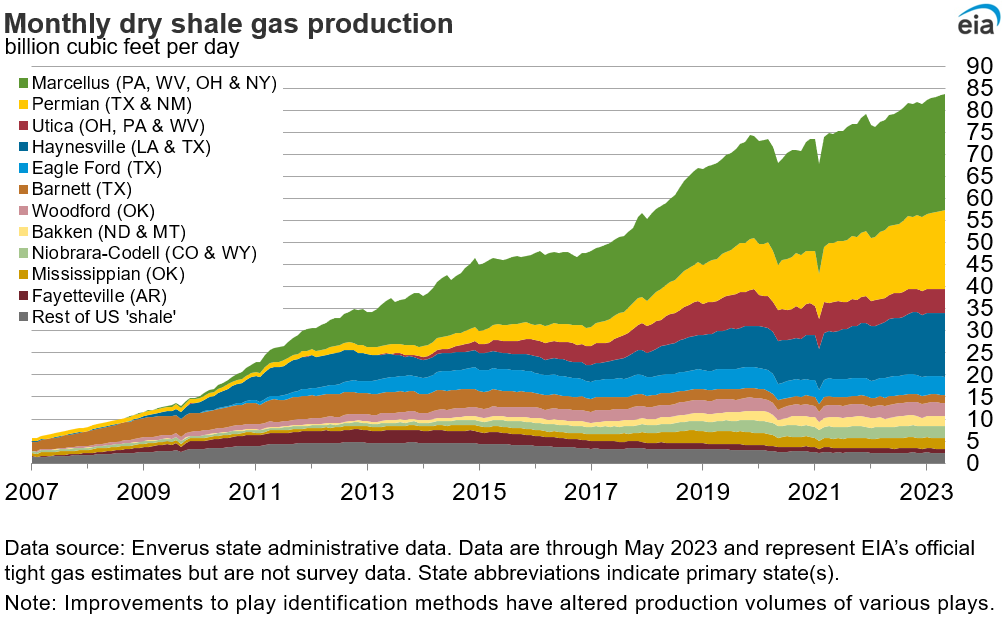In the News:
Natural gas-fired electricity generation was higher in first-half 2023 than in first-half 2022
Natural gas-fired electricity generation across the Lower 48 states increased by 9.7%, or 66.2 terawatthours (TWh), in the first half of 2023 (1H2023) compared with the first half of 2022 (1H2022), making it the single largest growing source of electricity generation, according to data from our Hourly Electric Grid Monitor. The increase in natural gas-fired generation was driven by lower natural gas prices and lower generation from other sources, in particular coal, and occurred despite a 2.9% (57.5 TWh) decline in total electricity generation, largely attributable to mild weather.
Natural gas-fired electricity generation peaks in the summer when electricity demand for air conditioning is highest due to seasonally high average temperatures. Another lower peak occurs during the winter, when use of heat pumps, electric radiators, space heaters, and other electric heating equipment to heat buildings increases in some parts of the United States. Over the first six months of this year, the cumulative number of population-weighted heating degree days across the Lower 48 states was 10.2% lower than the 10-year (2013–2022) average and 11.6% lower than 1H2022, while the cumulative number of cooling degree days was 23.1% lower than the 10-year average and 33.7% lower than 1H2022. This mild weather contributed to a decline in overall electricity generation compared with 1H2022.
Coal-fired electricity generation decreased the most out of all the fuel sources in 1H2023, declining 25.8% (107.2 TWh) compared with 1H2022. In the electric power sector, combined-cycle natural gas-fired generation units typically compete with coal-fired generation units to provide the lowest-cost wholesale electricity price for power suppliers. Coal-fired generation this year has been less economical compared with natural gas-fired generation, leading to price-driven coal-to-natural gas fuel switching.
The U.S. electric power sector natural gas cost averaged $3.74 per million British thermal units (MMBtu) in 1H2023, 43.3% ($2.85/MMBtu) lower than in 1H2022, while the electric power sector coal cost averaged $2.52/MMBtu in 1H2023, according to our Short-Term Energy Outlook. The electric power sector natural gas cost has been declining this year, averaging $2.39/MMBtu in June, while the electric power sector coal cost averaged $2.45/MMBtu in June.
Capacity additions have also contributed to the growth in natural gas-fired generation. Between 1H2022 and 1H2023, average U.S. natural gas-fired generation capacity increased by 1.5%, while coal-fired generation capacity decreased by 6.4%, continuing a long-term trend of coal capacity retirements. According to our Electric Power Monthly, over the 12 months ending in April 2023, 9.1 gigawatts (GW) of net natural gas-fired electric power generation capacity additions entered service, of which 93.4% (8.5 GW) were from combined-cycle natural gas turbine plants, which are among the most efficient natural gas plants and help improve the economics of natural gas-fired generation compared with other sources.
In addition to coal, smaller declines in electricity generation from wind (6.3%, or 15.2 TWh), hydropower (6.2%, or 9.0 TWh), nuclear (0.9%, or 3.5 TWh), and petroleum (20.5%, or 1.1 TWh) also contributed to increased natural gas-fired generation in 1H2023 compared with 1H2022, while electricity generation from solar power increased (8.3%, or 5.4 TWh).
Market Highlights:
(For the week ending Wednesday, July 19, 2023)Prices
- Henry Hub spot price: The Henry Hub spot price fell 4 cents from $2.55 per million British thermal units (MMBtu) last Wednesday to $2.51/MMBtu yesterday.
- Henry Hub futures prices: The price of the August 2023 NYMEX contract decreased 2.9 cents, from $2.632/MMBtu last Wednesday to $2.603/MMBtu yesterday. The price of the 12-month strip averaging August 2023 through July 2024 futures contracts declined 4 cents to $3.141/MMBtu.
- Select regional spot prices: Natural gas spot prices fell at most major pricing hubs this report week (Wednesday, July 12 to Wednesday, July 19), except on the West Coast. Price changes this week ranged from a decrease of $0.20/MMBtu at Tennessee Zone 4 Marcellus to an increase of $2.24/MMBtu at SoCal Citygate.
- Prices decreased in all Northeast markets this report week, despite warmer-than-average temperatures in New England and in New York City. At the Algonquin Citygate, which serves Boston-area consumers, the price went down 13 cents from $1.87/MMBtu last Wednesday to $1.74/MMBtu yesterday. At the Transcontinental Pipeline Zone 6 trading point for New York City, the price decreased 14 cents from $1.79/MMBtu last Wednesday to $1.65/MMBtu yesterday. In the Boston-Area, temperatures averaged 78°F this week, 4°F above normal, resulting in 17 more cooling degree days (CDDs) than last week and 29 more than normal. Temperatures in the New York-Central Park Area averaged 79°F this week, 1°F above normal, which resulted in 11 fewer CDDs than last week but 8 more than normal. Natural gas consumption in the Northeast power sector increased 1%, or 0.1 billion cubic feet per day (Bcf/d) week over week, according to data from S&P Global Commodity Insights.
- In western markets, from the Opal Hub in southwest Wyoming to Sumas on the Canada-Washington border, prices increased from last Wednesday to yesterday. The price at the Opal Hub rose 97 cents from $2.80/MMBtu last Wednesday to $3.77/MMBtu yesterday, and the price at Sumas rose 95 cents from $2.86/MMBtu last Wednesday to $3.81/MMBtu yesterday. Capacity reductions on the two major pipelines delivering natural gas into the Pacific Northwest continued this week. Gas Transmission Northwest extended its force majeure through July 24, reducing available capacity by approximately 0.4 Bcf/d at the Kingsgate delivery point in Boundary, Idaho. Available capacity on the Westcoast Energy Inc. pipeline, which delivers natural gas from British Columbia into Washington, continues to be down by approximately 0.5 Bcf/d.
- In California, the price at PG&E Citygate in Northern California rose 57 cents, up from $4.32/MMBtu last Wednesday to $4.89/MMBtu yesterday. The price at SoCal Citygate in Southern California increased $2.24 from $3.40/MMBtu last Wednesday to $5.64/MMBtu yesterday. Natural gas consumption in the electric power sector increased by 84% (1.3 Bcf/d) in California and by 10% (0.3 Bcf/d) in the desert Southwest this report week, according to data from S&P Global Commodity Insights, as above-normal temperatures increased air-conditioning demand. Temperatures in the Phoenix Area reached a daily high of 119°F Wednesday, and averaged 105°F this week, which resulted in 284 CDDs, 69 more CDDs than normal and 34 more than last week. Phoenix broke multiple heat records this week and the current weather pattern is expected to continue into next week.
- International futures prices: International natural gas futures prices decreased this report week. According to Bloomberg Finance, L.P., weekly average front-month futures prices for liquefied natural gas (LNG) cargoes in East Asia decreased 82 cents to a weekly average of $11.22/MMBtu. Natural gas futures for delivery at the Title Transfer Facility (TTF) in the Netherlands decreased $1.12 to a weekly average of $8.67/MMBtu. In the same week last year (week ending July 20, 2022), the prices were $38.11/MMBtu in East Asia and $47.59/MMBtu at TTF.
- Natural gas plant liquids (NGPL) prices: The natural gas plant liquids composite price at Mont Belvieu, Texas, rose by 79 cents/MMBtu, averaging $7.04/MMBtu for the week ending July 19. Weekly average ethane prices rose 26%, while natural gas prices at the Houston Ship Channel rose by 1%, resulting in an increase of the ethane premium to natural gas by 56% week over week. Ethylene spot prices rose 2%, decreasing the ethylene to ethane premium by 30%. Propane prices rose 5%, while the Brent crude oil price rose 1%, decreasing the propane discount relative to crude oil by 3%. The normal butane price rose 10%, the isobutane price rose 17%, and the natural gasoline price rose 4%.
Daily spot prices by region are available on the EIA website.
Supply and Demand
- Supply: According to data from S&P Global Commodity Insights, the average total supply of natural gas fell by 0.3% (0.4 Bcf/d) compared with the previous report week. Dry natural gas production decreased by 0.9% (0.9 Bcf/d) to 101.0 Bcf/d, and average net imports from Canada increased by 9.6% (0.5 Bcf/d) to 6.0 Bcf/d from last week.
- Demand: Total U.S. consumption of natural gas rose by 5.4% (3.9 Bcf/d) compared with the previous report week, according to data from S&P Global Commodity Insights. Natural gas consumed for power generation rose by 8.5% (3.6 Bcf/d) week over week with above-average temperatures in Texas, the Southwest, and California in particular. Industrial sector consumption increased by 0.6% (0.1 Bcf/d) week over week, and in the residential and commercial sectors, consumption increased by 1.4% (0.1 Bcf/d). Natural gas exports to Mexico decreased 3.2% (0.2 Bcf/d). Natural gas deliveries to U.S. LNG export facilities (LNG pipeline receipts) averaged 12.5 Bcf/d, or 0.1 Bcf/d higher than last week.
Liquefied Natural Gas (LNG)
- Pipeline receipts: Average natural gas deliveries to U.S. LNG export terminals increased by 0.9% (0.1 Bcf/d) week over week to 12.5 Bcf/d this report week, according to data from S&P Global Commodity Insights. Natural gas deliveries to terminals in South Texas increased by 4.5% (0.2 Bcf/d) to 4.1 Bcf/d, while deliveries to terminals in South Louisiana decreased by 1.0% (0.1 Bcf/d) to 7.3 Bcf/d. Natural gas deliveries to terminals outside the Gulf Coast were essentially unchanged at 1.1 Bcf/d.
- Vessels departing U.S. ports: Twenty-two LNG vessels (seven from Sabine Pass, five from Corpus Christi, three each from Cameron and Freeport, and two each from Calcasieu Pass and Cove Point) with a combined LNG-carrying capacity of 82 Bcf departed the United States between July 13 and July 19, according to shipping data provided by Bloomberg Finance, L.P.
- Vessels arriving at U.S. ports: One LNG vessel with a carrying capacity of 3 Bcf docked for off-loading at the Everett LNG terminal in Boston Harbor in Massachusetts between July 13 and July 19, according to shipping data provided by Bloomberg Finance, L.P.
Rig Count
- According to Baker Hughes, for the week ending Tuesday, July 11, the natural gas rig count decreased by 2 rigs from a week ago to 133 rigs. The Eagle Ford, Haynesville, and Permian each dropped one rig, and one rig was added in an unidentified producing basin. The number of oil-directed rigs decreased by 3 rigs from a week ago to 537 rigs. The Permian dropped four rigs, the Cana Woodford and Mississippian each dropped one rig, one rig was added in the Williston, and two rigs were added in unidentified producing basins. The total rig count, which includes 5 miscellaneous rigs, stands at 675, 81 fewer rigs than last year at this time.
Storage
- The net injections into storage totaled 41 Bcf for the week ending July 14, compared with the five-year (2018–2022) average net injections of 45 Bcf and last year's net injections of 35 Bcf during the same week. Working natural gas stocks totaled 2,971 Bcf, which is 360 Bcf (14%) more than the five-year average and 575 Bcf (24%) more than last year at this time.
- According to The Desk survey of natural gas analysts, estimates of the weekly net change to working natural gas stocks ranged from net injections of 37 Bcf to 57 Bcf, with a median estimate of 44 Bcf.
- The average rate of injections into storage is 6% higher than the five-year average so far in the refill season (April through October). If the rate of injections into storage matched the five-year average of 9.0 Bcf/d for the remainder of the refill season, the total inventory would be 3,955 Bcf on October 31, which is 360 Bcf higher than the five-year average of 3,595 Bcf for that time of year.
See also:
Top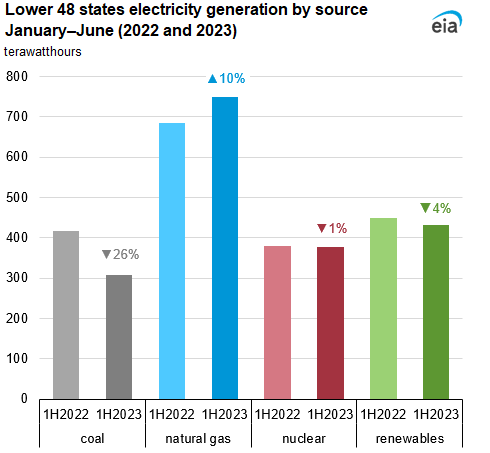 Data source: U.S. Energy Information Administration, Note: Renewables includes solar, wind, and hydroelectric generation. 1H is the first six months of the given year.
Data source: U.S. Energy Information Administration, Note: Renewables includes solar, wind, and hydroelectric generation. 1H is the first six months of the given year.
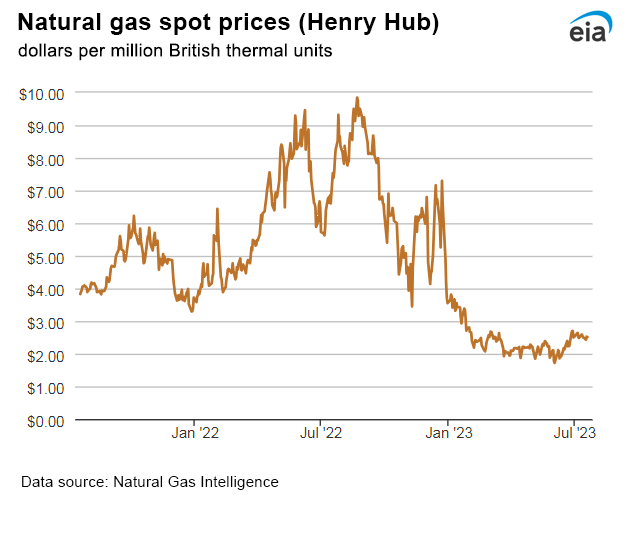
| Spot Prices ($/MMBtu) | Thu, 13-Jul |
Fri, 14-Jul |
Mon, 17-Jul |
Tue, 18-Jul |
Wed, 19-Jul |
|---|---|---|---|---|---|
| Henry Hub |
2.50 |
2.49 |
2.43 |
2.52 |
2.51 |
| New York |
1.65 |
1.57 |
1.69 |
1.87 |
1.65 |
| Chicago |
2.29 |
2.24 |
2.27 |
2.30 |
2.33 |
| Cal. Comp. Avg.* |
3.71 |
4.05 |
4.76 |
4.39 |
4.27 |
| Futures ($/MMBtu) | |||||
| August contract | 2.545 |
2.539 |
2.512 |
2.629 |
2.603 |
| September contract |
2.534 |
2.530 |
2.504 |
2.618 |
2.585 |
| *Avg. of NGI's reported prices for: Malin, PG&E Citygate, and Southern California Border Avg. | |||||
| Data source: NGI's Daily Gas Price Index | |||||
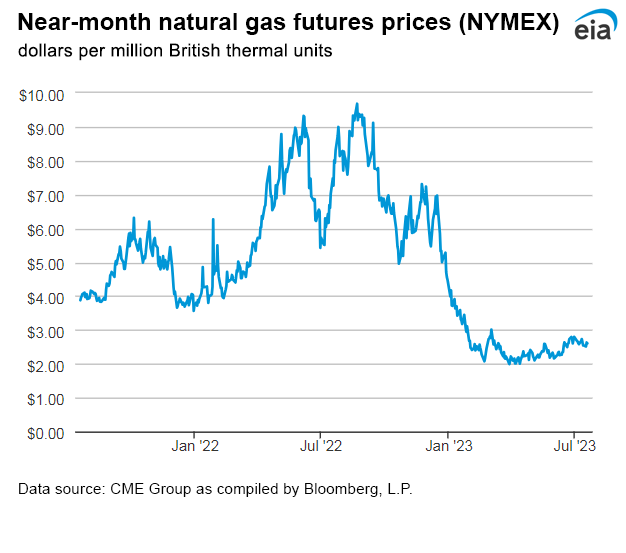
| U.S. natural gas supply - Gas Week: (7/13/23 - 7/19/23) | |||
|---|---|---|---|
Average daily values (billion cubic feet) |
|||
this week |
last week |
last year |
|
| Marketed production | 113.3 |
114.4 |
111.0 |
| Dry production | 101.0 |
101.9 |
98.2 |
| Net Canada imports | 6.0 |
5.5 |
6.1 |
| LNG pipeline deliveries | 0.1 |
0.1 |
0.0 |
| Total supply | 107.1 |
107.4 |
104.3 |
|
Data source: S&P Global Commodity Insights | |||
| U.S. natural gas consumption - Gas Week: (7/13/23 - 7/19/23) | |||
|---|---|---|---|
Average daily values (billion cubic feet) |
|||
this week |
last week |
last year |
|
| U.S. consumption | 76.3 |
72.4 |
75.1 |
| Power | 46.2 |
42.6 |
45.7 |
| Industrial | 21.4 |
21.3 |
21.2 |
| Residential/commercial | 8.7 |
8.6 |
8.2 |
| Mexico exports | 6.3 |
6.5 |
6.4 |
| Pipeline fuel use/losses | 7.0 |
7.0 |
6.8 |
| LNG pipeline receipts | 12.5 |
12.4 |
11.1 |
| Total demand | 102.1 |
98.3 |
99.4 |
|
Data source: S&P Global Commodity Insights | |||
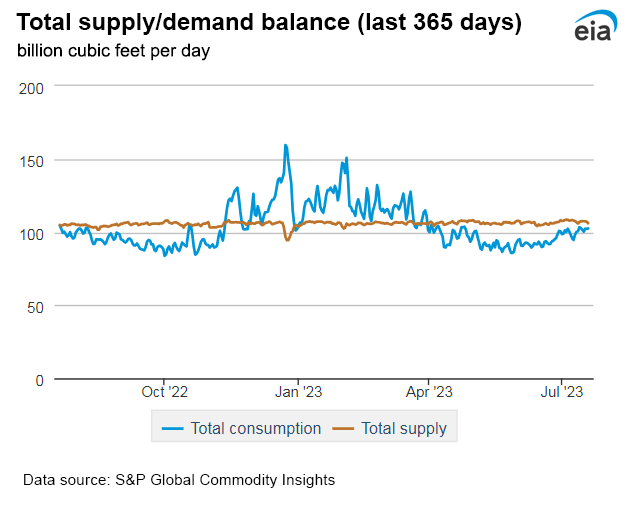
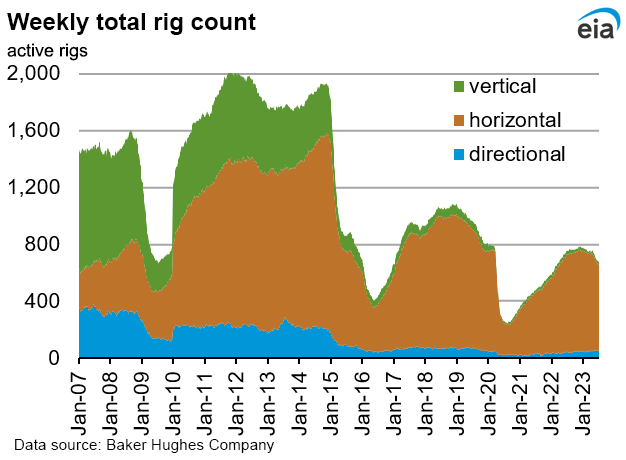
| Rigs | |||
|---|---|---|---|
Tue, July 11, 2023 |
Change from |
||
last week |
last year |
||
| Oil rigs | 537 |
-0.6% |
-10.4% |
| Natural gas rigs | 133 |
-1.5% |
-13.1% |
| Note: Excludes any miscellaneous rigs | |||
| Rig numbers by type | |||
|---|---|---|---|
Tue, July 11, 2023 |
Change from |
||
last week |
last year |
||
| Vertical | 17 |
6.3% |
-43.3% |
| Horizontal | 606 |
-0.8% |
-11.7% |
| Directional | 52 |
-1.9% |
30.0% |
| Data source: Baker Hughes Company | |||
| Working gas in underground storage | ||||
|---|---|---|---|---|
Stocks billion cubic feet (Bcf) |
||||
| Region | 2023-07-14 |
2023-07-07 |
change |
|
| East | 661 |
653 |
8 |
|
| Midwest | 741 |
724 |
17 |
|
| Mountain | 186 |
180 |
6 |
|
| Pacific | 232 |
225 |
7 |
|
| South Central | 1,150 |
1,147 |
3 |
|
| Total | 2,971 |
2,930 |
41 |
|
|
Data source: U.S. Energy Information Administration Form EIA-912, Weekly Underground Natural Gas Storage Report
Note: Totals may not equal sum of components because of independent rounding. | ||||
| Working gas in underground storage | |||||
|---|---|---|---|---|---|
Historical comparisons |
|||||
Year ago (7/14/22) |
5-year average (2018-2022) |
||||
| Region | Stocks (Bcf) |
% change |
Stocks (Bcf) |
% change |
|
| East | 518 |
27.6 |
567 |
16.6 |
|
| Midwest | 605 |
22.5 |
642 |
15.4 |
|
| Mountain | 144 |
29.2 |
161 |
15.5 |
|
| Pacific | 252 |
-7.9 |
268 |
-13.4 |
|
| South Central | 876 |
31.3 |
972 |
18.3 |
|
| Total | 2,396 |
24.0 |
2,611 |
13.8 |
|
| Data source: U.S. Energy Information Administration Form EIA-912, Weekly Underground Natural Gas Storage Report
Note: Totals may not equal sum of components because of independent rounding. |
|||||
| Temperature – heating & cooling degree days (week ending Jul 13) | ||||||||
|---|---|---|---|---|---|---|---|---|
HDDs |
CDDs |
|||||||
| Region | Current total |
Deviation from normal |
Deviation from last year |
Current total |
Deviation from normal |
Deviation from last year |
||
| New England | 0 |
-1 |
-2 |
68 |
29 |
31 |
||
| Middle Atlantic | 0 |
-1 |
0 |
74 |
20 |
17 |
||
| E N Central | 2 |
1 |
1 |
42 |
-12 |
-9 |
||
| W N Central | 7 |
3 |
7 |
47 |
-22 |
-28 |
||
| South Atlantic | 0 |
0 |
0 |
103 |
7 |
7 |
||
| E S Central | 0 |
0 |
0 |
83 |
-9 |
-21 |
||
| W S Central | 0 |
0 |
0 |
135 |
13 |
-19 |
||
| Mountain | 1 |
-6 |
0 |
87 |
11 |
-6 |
||
| Pacific | 1 |
-4 |
0 |
42 |
2 |
-8 |
||
| United States | 1 |
-1 |
1 |
75 |
3 |
-3 |
||
|
Data source: National Oceanic and Atmospheric Administration Note: HDDs=heating degree days; CDDs=cooling degree days | ||||||||
Average temperature (°F)
7-day mean ending Jul 13, 2023
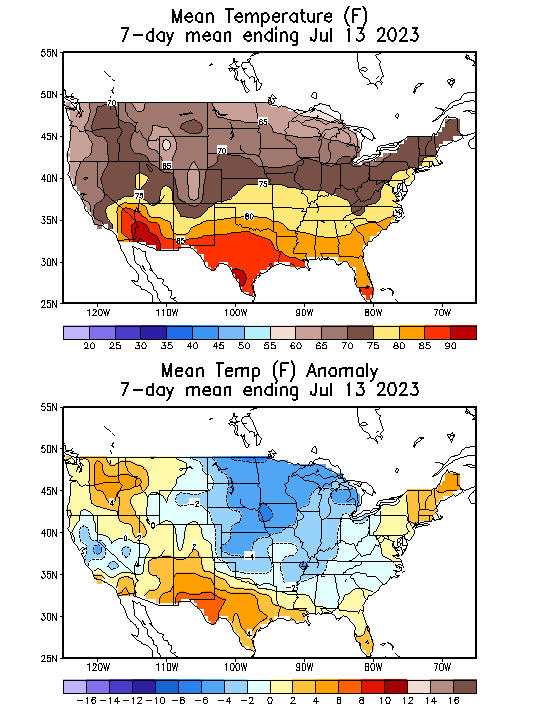
Data source: National Oceanic and Atmospheric Administration
Deviation between average and normal temperature (°F)
7-day mean ending Jul 13, 2023

Data source: National Oceanic and Atmospheric Administration

